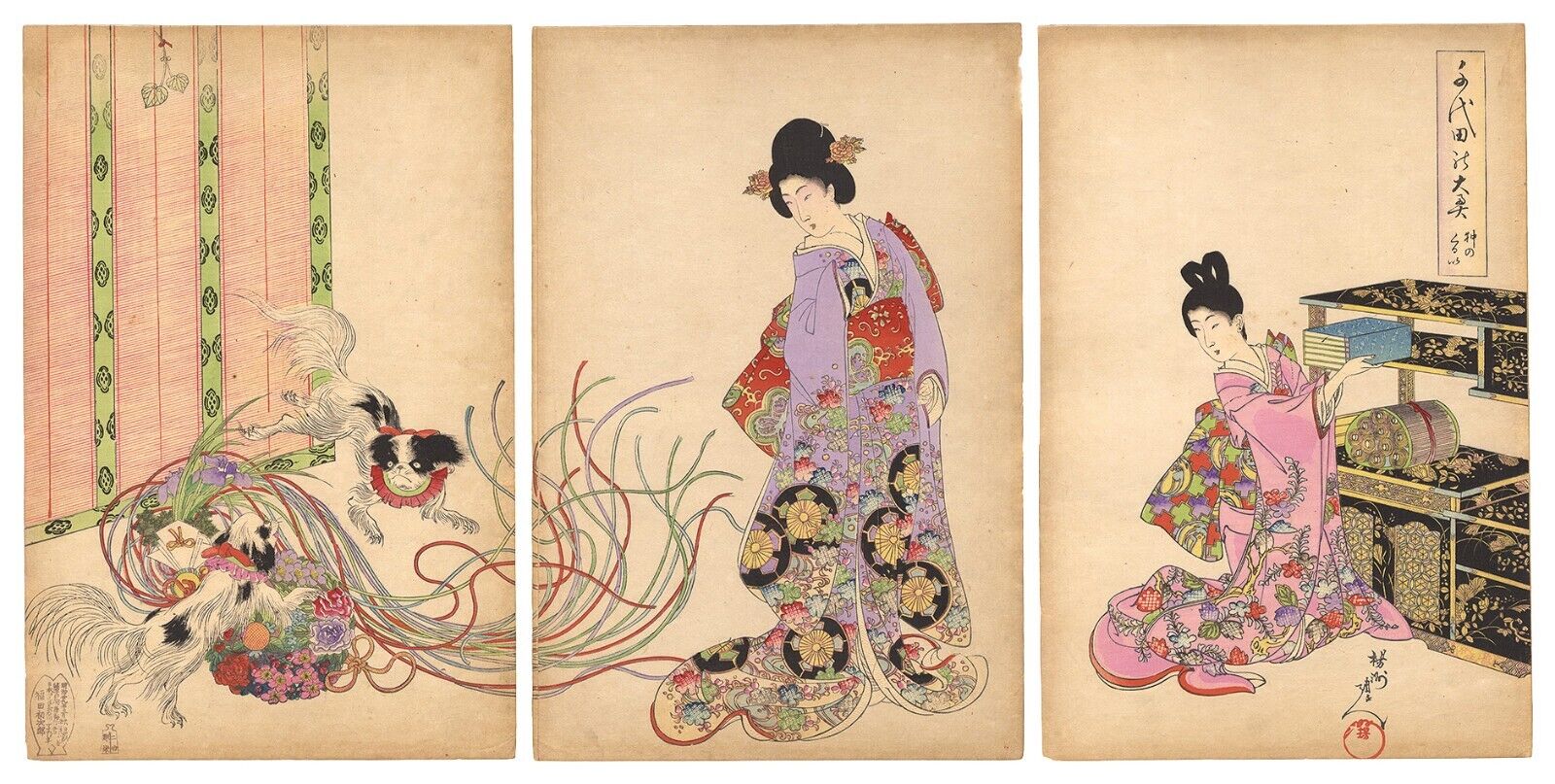-40%
☆Rare Gem☆ Antique Hokusai 19th Century Woodblock Print Yōkai Ukiyo-e Tattoo Art
$ 55.44
- Description
- Size Guide
Description
ICONIC, WOODBLOCK BOOKPLATE FROM HOKUSAI’S MANGA VOL. 12Hokusai Manga:
伝神開手
(Denshin Kaishu) Transmitted From the Gods, A Revelation of All Things.
The title slip from the book that this particular example was extracted from reads, “Katsushika Hokusai Denshin Kaishu 12 All” (All is very significant, in that it marks this particular book as an early pull off the blocks to be showcased in a complete set of all 15 books of Manga).
Close examination reveals fine details that are normally lost in late Edo-era, early Meiji versions. In other words, there are real dogs out there, whole books not worthy of the price of postage. Why stunning impressions from the original blocks appeared well into the Meiji Era is a mystery yet to be answered—as mysterious as why Hokusai’s own prefaces, to his own books of Manga, have yet to be translated into English.
RARE BOOKPLATE.
EXCELLENT REGISTRY AND IMPRESSION. SHARP DETAILS. EVENLY PRINTED. NO ISSUES. AN OBVIOUS EARLY PULL OFF THE BLOCKS! VERY LITTLE TO NO TONING TO THE PAPER. IMPECCABLE STATE OF PRESERVATION. NO THUMBING AT ALL. CHOICE!!!
Each leaf measures approx. 5.5” x 9.5”
DON’T MISS OUT ON THIS OPPORTUNITY TO ADD A VERY RARE, CLEAN EXAMPLE FROM HOKUSAI’S FAMOUS MANGA VOL. 12, PRINTED NEARLY 150 YEARS AGO.
————————–——————
Several facts regarding hand-made washi paper:
Tone, texture and thickness vary a lot when printing on hand-made paper that was produced by farmers during the winter months. As well, washi, being that it is hand-made paper, occasionally had large brown fibers or other materials that entered the water and paper vats used in production. These blemishes are of course not a misprint or damage. It seems that printmakers of that time were neither obsessive nor selective about the uniformity of each individual sheet of paper. After all, these books were never printed for elite collectors with safe-deposit boxes. In fact, they were intended to magnify the hearts and minds of Everyman.
————————–——————
BREIF HISTORY OF THE MANGA*
The fifteen volumes of
Hokusai manga
combined include roughly 4,000 pages of illustration. The first ten volumes were published between
1814
and
1819
. The next two came out more than ten years later, in
1832
-
1833
, and
1834
, respectively. The publication date for volumes 13 and 14 are unknown; the final volume was published posthumously in
1878
, nearly 30 years after Hokusai’s death, but, unlike volume 14, carrying his signature.
One volume of (Denshin kaishu) Hokusai manga [“(Transmitting the Spirit and Revealing the Form of Things) Random Drawings of Hokusai”] was probably all that was originally planned, but the book exploded on the scene and instantly became the all-time best-selling book in Japan up until that time. It was so popular and widely acclaimed over such a long period of time that 14 additional volumes of Hokusai’s manga were published during the next 64 years. The last three books of the series, however, were created after Hokusai’s death in 1849 at the age of eighty-nine. Two were comprised of unpublished sketches that had been collected by the publisher and the final volume contained a selection of previously published drawings by Hokusai and works by other artists. Many art historians find this last book problematic: a spurious attempt to cash in on the continuing popularity of Hokusai’s artwork in the late 19th century. *Credit Princeton University.
————————–——————
Pardon the editorial, but Hokusai was—as all true poet/creators are—an agent of revelation. Lordy, if our man from Edo cast his interested gaze into the crinkles of our everyday-workaday tinfoil, he’d have revealed what no man had ever considered worthy of revelation. Hokusai rocked rock. Rocked whatever he set minds eye to!
“The poets eye, in a fine frenzy rolling, doth glance from heaven to earth, earth to heaven, and through perception bodies forth the shapes of things unknown, and to airy nothing gives a local habitation and a name.” —William Shakespeare
The Revelation of All Things, or so the conceit goes, must surely have hatched in a Midsummer Night’s Dream.
A single work by an artists such as
Hokusai is a daily reminder of the revelation that is the world around us.
“A
book is a garden, an orchard, a storehouse, a party, a company by the way, a counselor, a multitude of counselors.”
—
Charles Baudelaire
The same holds true for a book of unparalleled drawings, or a print from one adoring our walls.
————————–——————
A bit of friendly advice on matting bookplate diptych prints before framing:
All bookplates that I have up for auction haven’t been butchered down the center seam waiting to be pieced together. Since these images were never intended to be assembled as a single print no attempt has been made to do so. Personally, and for justifiable aesthetic reasons, I prefer to mat bookplate diptychs with a half inch or 1.2 centimeter space left between the two separate panels. It is also more archival, saving the print from harmful and messy taping or glueing at the seam. If you do attempt this, you may find that the two halves don’t even line up from top to bottom (end result—you’ll be wearing a suit from a tailor who’s not paid the dues). Remember, once this action is done it can’t be undone. When considering the fact that the art is forever fresh and alive as it is, what reason is there to meddle with it by reassembling it to your particular preferences (hubris perhaps?). Just a bit of friendly advise, but as always, I leave such matters to the discretion of the buyer.












